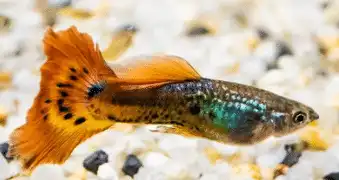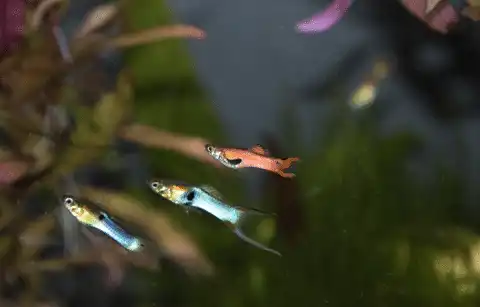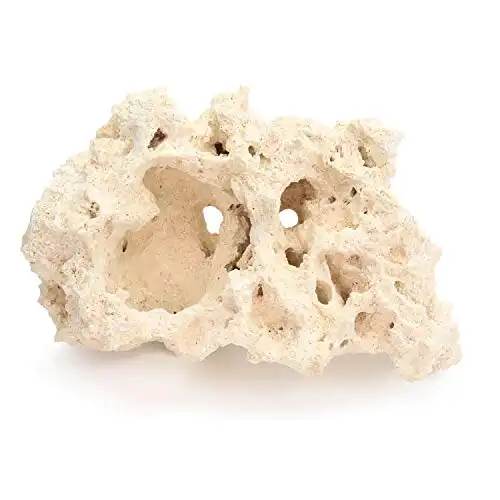Thank you for visiting! By the way… any links on this page that lead to products on Amazon and other stores/partners are affiliate links Aquarium Store Depot earns a commission if you make a purchase.
Brackish water aquarium fish are some of the most fascinating species in the hobby. Not quite freshwater, but not fully marine either, these fish fall into their own category. If you’re looking to start your own brackish tank, or just looking to learn more about this awesome side of the fish-keeping hobby, this article is for you!
Read on to learn about the best brackish water aquarium fish species that you can keep, and for some great tips on setting up their tank.
What Are They?
Brackish fish are native to environments where fresh and saltwater mix. These environments are common in coastal areas all over the world, particularly where rivers and streams meet the ocean.
This type of habitat is known as an estuary, although brackish coastal lakes also exist. The salinity of brackish water varies with the tides and other factors like river water levels. As a result, these brackish water fish species must either move with the water or be adaptable to these changeable conditions.
Brackish fish are technically known as euryhaline species1, which means they can adapt to different salinities. They can often live in fully fresh or marine water for certain periods of time, but they are most comfortable in that in-between range for the long term.
Why Keep this type?
There are many reasons to keep a brackish aquarium. The most obvious is probably because there are some truly amazing-looking brackish fish species! In fact, many of the fish sold as freshwater fish are actually brackish. If you want to give these fish the best care, you’re going to need to go brackish.
Apart from the fish themselves, the brackish environment is a fascinating underwater world. A Brackish water environment is an exciting new challenge for anyone who has started out with a tropical freshwater tank.
15 Best Brackish Water Fish
Now that you know what a brackish aquarium fish is, it’s time to get to know some of the best types! All of these species are suitable for the home aquarium, but their care and space requirements differ very much. I have a video above from our official YouTube Channel for a visual. Our blog will go in more detail below. That’s why I’ve put together the following list of vital stats for each species:
- Scientific Name
- Difficulty Level
- Temperament
- Adult Size
- Minimum Tank Size
- Diet
- Origin
- Temperature
- Water salinity/specific gravity
- pH
- Difficulty to breed
Let’s get started!
1. Mollies
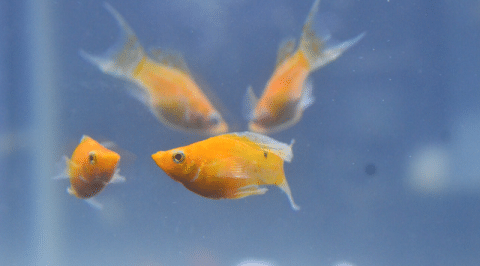
- Scientific Name: Poecilia latipinna, Poecilia sphenops
- Difficulty Level: Easy
- Temperament: Peaceful/semi-aggressive
- Adult Size: 5-7 inches
- Minimum Tank Size: 15 gallons
- Diet: Feed dried and live/frozen food, spirulina/vegetable matter
- Origin: USA, Mexico, Northern South America
- Temperature: 72-82°F
- Water salinity/specific gravity: 1.005-1.015
- pH: 7-8.5
- Difficulty to breed: Easy
Molly fish are highly adaptable fish that can be kept in anything from hard freshwater all the way to full marine conditions. In fact, these inexpensive livebearers thrive in brackish conditions!
There are a few different species and many different breeds available in the fish-keeping hobby. Check out my complete guide for more details on these awesome beginner brackish aquarium fish!
2. Guppy Fish
An undemanding fish that is a livebearer. Many varieties available
- Scientific Name: Poecilia reticulata
- Difficulty Level: Easy
- Temperament: Peaceful
- Adult Size: 1.5-2.5 inches
- Minimum Tank Size: 10 gallons
- Diet: Feed dried and live/frozen foods, spirulina/vegetable matter
- Origin: Northern South America & Caribbean Islands
- Temperature: 63-82°F
- Water salinity/specific gravity: 1.001-1.010
- pH: 7-8.5
- Difficulty to breed: Easy
Guppies are the smaller, more colorful cousins to the molly fish. These popular livebearers are one of the most common species in the aquarium trade. They are available in an amazing variety of shapes and colors, and they’re really easy to breed in the home aquarium.
Guppy fish is usually thought of as freshwater fish species, but they can be kept in brackish water too. In fact, studies have shown that these amazing fish can even tolerate full marine conditions.
3. Endler’s Livebearers
A very active and colorful livebearer. Smaller in size than guppies
- Scientific Name: Poecilia wingei
- Difficulty Level: Easy
- Temperament: Peaceful
- Adult Size: 1-1.8 inches
- Minimum Tank Size: 10 gallons
- Diet: Feed dried and live/frozen foods, spirulina/vegetable matter
- Origin: Venezuela, South America
- Temperature: 75-86°F
- Water salinity/specific gravity: 1.001-1.025
- pH: 7-8.5
- Difficulty to breed: Easy
The Endler’s livebearer is another great nano brackish fish. These hardy fish thrive in brackish environments, even though they are usually kept in freshwater.
The males of these tiny fish are much smaller and more colorful than the females, so if you don’t want them to breed, males are the better choice. Endler’s livebearers should not be kept with large fish or aggressive tank mates.
4. Archer
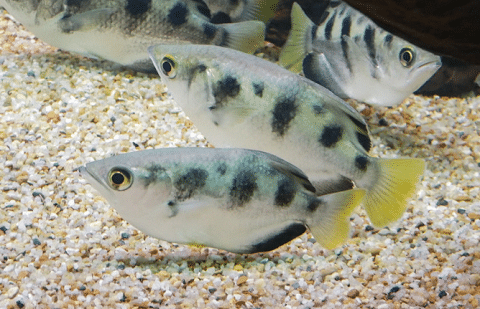
- Scientific Name: Toxotes jaculatrix
- Difficulty Level: Moderate
- Temperament: Semi-aggressive
- Adult Size: 12 inches
- Minimum Tank Size: 125 gallons
- Diet: Feed dried & live/frozen foods
- Origin: Widespread in Southern Asia and Northern Australia
- Temperature: 77-86°F
- Water salinity/specific gravity: 1.005-1.010
- pH: 7-8
- Difficulty to breed: Advanced
Archerfish are brackish fish species with a fascinating hunting technique. In their natural habitat, these intelligent fish spit water at insects on leaves and tree branches above the water. This knocks the prey onto the water surface where the fish can get to it. Pretty neat!
They will also take regular flake food and do great in larger brackish water aquariums. These fish are generally very peaceful with other fish but can be a little nippy with other archerfish unless kept in groups of 4 or more.
5. Scat

- Scientific Name: Scatophagus argus
- Difficulty Level: Moderate
- Temperament: Semi-aggressive
- Adult Size: 15 inches
- Minimum Tank Size: gallons
- Diet: Dried foods, live/frozen foods, vegetable matter
- Origin: The Middle East to Australia
- Temperature: 68-82°F
- Water salinity/specific gravity: 1.005-1.025
- pH: 7.5-8.5
- Difficulty to breed: Advanced
Scats are large and beautiful brackish water aquarium fish. These spotted fish look amazing in schools in large aquariums. These curious fish make wonderful pets and are easy to feed and care for.
The secret is to keep them in groups of at least 4 fish, maintain excellent water quality in a large enough tank, and always make sure their water is in the preferred salinity range.
6. Mono
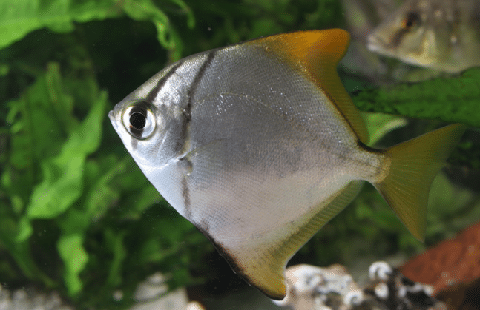
- Scientific Name: Monodactylus argenteus, M. sebae
- Difficulty Level: Advanced
- Temperament: Semi-aggressive
- Adult Size: 10 inches
- Minimum Tank Size: 125 gallons
- Diet: Dried foods, live/frozen foods, vegetable matter
- Origin: Widespread along African and Asian coasts
- Temperature: 75-82°F
- Water salinity/specific gravity: 1.005-1.025
- pH: 7.2-8.4
- Difficulty to breed: Advanced
These beautiful silvery fish are very fast and active so they require a large aquarium with plenty of swimming space. They make great tank mates for other brackish fish like scats, although they do equally well in full marine tanks. Mono fish can be skittish and are known to be fin nippers too, so they are best left to expert aquarists.
7. Green Spotted Puffer

- Scientific Name: Tetraodon nigroviridis
- Difficulty Level: Moderate
- Temperament: Semi-aggressive
- Adult Size: 6 inches
- Minimum Tank Size: 30 gallons
- Diet: Live/ frozen foods, and hard-shelled food sources like snails are essential
- Origin: India to Southeast Asia
- Temperature: 75-82°F
- Water salinity/specific gravity: 1.005
- pH: 7.5-8.5
- Difficulty to breed: Advanced
The green spotted puffer is an amazing brackish water aquarium fish for more experienced fish keepers. These active puffers can be kept with other fish in a community setup, but they should be the only pufferfish in the tank to avoid aggression.
Pufferfish have beak-like teeth that grow continuously. It is very important to feed these fish hard food like snails and shellfish to keep their teeth worn down.
8. Figure 8 puffer
- Scientific Name: Tetraodon biocellatus
- Difficulty Level: Moderate
- Temperament: Semi-aggressive
- Adult Size: 3 inches
- Minimum Tank Size: 20 gallons
- Diet: Live/ frozen foods, hard-shelled food sources like snails are essential
- Origin: Southeast Asia
- Temperature: 72-79°F
- Water salinity/specific gravity: 1.005
- pH: 6.5-7.5
- Difficulty to breed: Advanced
The figure 8 puffer fish is an awesome species that can be kept in both fresh and brackish water conditions. They get their name from the interesting markings on their backs. These little fish are generally peaceful but they are known to nip the fins of slow-moving tankmates
9. Bumblebee Goby
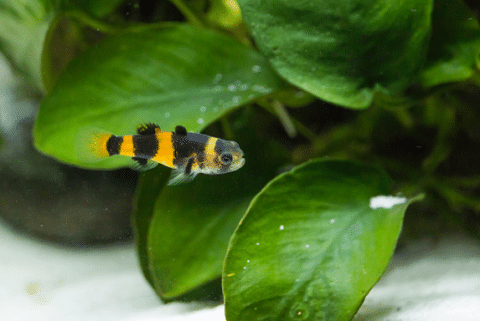
- Scientific Name: Brachygobius doriae
- Difficulty Level: Moderate
- Temperament: Semi-aggressive
- Adult Size: 1-1.5 inches
- Minimum Tank Size: 10 gallons
- Diet: Feed live food
- Origin: Borneo
- Temperature: 72-82°F
- Water salinity/specific gravity: 1.001-1.006
- pH: 7-8.5
- Difficulty to breed: Moderate
These nano fish are best for a small species only tank. They get their name from their bold black and yellow colors. This fish can be a bit of a picky eater and they generally prefer live food.
The bumblebee goby can be a little aggressive with other members of its own species so it is best to keep at least 6 together to prevent anyone from getting singled out. A brackish aquarium with plenty of hiding places is ideal for the bumblebee goby.
10. Dragon goby
- Scientific Name: Gobioides broussonnetii
- Difficulty Level: Moderate
- Temperament: Semi-aggressive
- Adult Size: 15-25 inches
- Minimum Tank Size: 125 gallons
- Diet: Feed algae wafers, live/frozen foods
- Origin: Widespread along the North, Central & South American coasts
- Temperature: 73-79°F
- Water salinity/specific gravity: 1.005-1.015
- pH: 7.5-9
- Difficulty to breed: Advanced
The dragon goby is a strange, eel-like fish. Dragon gobies are actually a whole lot more peaceful than they look or sound though.
They are not known to bother or eat smaller fish, although they can be semi-aggressive to other members of their own species. The Dragon goby can grow really long, so they should be kept in large tanks for good long-term care.
11. Orange Chromide
- Scientific Name: Etroplus maculatus
- Difficulty Level: Moderate
- Temperament: Peaceful
- Adult Size: 3 inches
- Minimum Tank Size: 20 gallons
- Diet: Feed, dried and live/frozen foods, spirulina/vegetable matter
- Origin: India & Sri Lanka
- Temperature: 68-82°F
- Water salinity/specific gravity: 1.002-1.010
- pH: 7-8.5
- Difficulty to breed: Moderate
Orange chromides (video source) can be kept in both fresh and brackish waters. This beautiful fish requires great quality water so regular aquarium maintenance is very important.
They are peaceful but will eat very small fish if they can catch them. Provide your orange chromides with a varied diet that includes both meaty foods and plant matter.
12. Kribensis
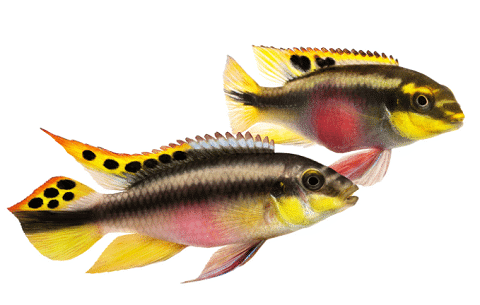
- Scientific Name: Pelvicachromis pulcher
- Difficulty Level: Easy
- Temperament: Semi-aggressive
- Adult Size: 3-4 inches
- Minimum Tank Size: 20 gallons
- Diet: Cichlid pellets, frozen/live foods
- Origin: Cameroon and Nigeria
- Temperature: 75-81°F
- Water salinity/specific gravity: 1.000-1.005
- pH: 5-7.5
- Difficulty to breed: Easy
Kribensis cichlids are usually kept in freshwater tanks but they can survive in slightly brackish water too. These fish have beautiful colors and bold horizontal stripes that can really brighten up your tank.
These beautiful West African cichlids are very peaceful except when breeding. It is best to keep a single pair with other fish in a community tank.
13. Golden Wonder Killifish
- Scientific Name: Aplocheilus lineatus
- Difficulty Level: Easy
- Temperament: Semi-aggressive
- Adult Size: 4 inches
- Minimum Tank Size: 20 gallons
- Diet: Feed dried, frozen/live foods
- Origin: India & Sri Lanka
- Temperature: 72-77°F
- Water salinity/specific gravity: 1.000-1.005
- pH: 6-7.5
- Difficulty to breed: Moderate
The golden wonder killifish (video source), or striped panchax, is another great species that can be kept in either fresh or slightly brackish water. These predatory fish will eat smaller fish, so they should only be kept with similarly sized fish. These hardy and adaptable killifish spend most of their time at the top of the tank.
14. Banded Banjo Catfish
- Scientific Name: Platystacus cotylephorus
- Difficulty Level: Easy
- Temperament: Peaceful
- Adult Size: 12 inches
- Minimum Tank Size: 30 gallons
- Diet: Sinking dried foods, live/frozen food
- Origin: Widespread in Central & South America
- Temperature: 72-77 °F
- Water salinity/specific gravity: 1.003-1.010
- pH: 6-8.2
- Difficulty to breed: Advanced
The banded banjo catfish (video source) is nocturnal fish with a very unusual body shape. These fish aren’t the most active or exciting to watch, but they still make a great oddball specimen for a brackish tank. They make great community fish but should not be kept with very small fish that could be swallowed whole.
15. Colombian shark catfish

- Scientific Name: Ariopsis seemanni
- Difficulty Level: Advanced
- Temperament: Peaceful
- Adult Size: 12-14 inches
- Minimum Tank Size: 225 gallons
- Diet: Meaty foods, can be picky eaters
- Origin: Coastal regions of eastern Central and South America
- Temperature: 72-78 °F
- Water salinity/specific gravity: 1.015-1.025
- pH: 6.8-8.5
- Difficulty to breed: Advanced
The Colombian shark catfish is not an aggressive fish but it will swallow any smaller fish that it can catch. These are large fish so they should not be purchased unless you have plenty of room.
One important thing to note is that their fins have venomous spines that can cause serious pain and swelling. This means you should be very careful about handling these fish.
Tank Setup
Setting up a great brackish aquarium is not that different from setting up a regular tropical fish tank. Let’s take a look at how to set up a brackish water aquarium.
Substrate & Decorations
You have a few choices when it comes to the substrate for brackish tanks.
Aragonite is an excellent option because it releases calcium carbonate into the water which helps to maintain stable and healthy high pH levels. This substrate looks great and is easy to clean. Aragonite is available in various colors and textures from fine sand to larger particles.
Crushed coral is another great option for a brackish tank but is a little more difficult to maintain because of the larger grain size. You can still get the benefits of this material by putting some into your filter media compartment.
This dry rock from ARC reef is mined from the Earth and is completely eco-friendly
When it comes to decorations, you can use any aquarium safe ornaments that are suitable for saltwater. Rocks are a great choice but small amounts of driftwood can be used too. Avoid large amounts of driftwood, however, since they can leach tannins and lower the water pH to some degree.
Planted Tanks
It will be surprising for some aquarists to hear that you can in fact grow live plants in a brackish water aquarium. The water’s specific gravity or salinity levels certainly do play a role in what kind of plants can be grown, however.
On the higher salinity end, few common aquarium plants will be able to survive. There are options, however, including the various mangrove species, seagrasses, and algae.
Fortunately, many well-known aquarium plants are adaptable to low salinity levels. The following species can be grown in slightly brackish water:
- Marimo moss balls
- Java fern
- Microsword
Lighting & Filtration
Unless you are growing live plants, bright lighting is not required for a brackish tank. The timing of your lighting is important, however. Maintain a regular day/night schedule for your fish by setting your lighting on a timer. 6 to 8 hours per day is recommended.
You can use a regular hang-on back or internal power filter in your brackish water aquarium, but canister filters are preferred because they hold so much more filtration media.
For The Professional Aquascaper
With an easy to remove prefilter chamber and intregrated heater chamber, this is the most advanced canister filter you can buy today. German engineered and aquascaper approved!
How To Take Care
Apart from their specific salinity needs, brackish fish have much the same needs as any other species. Read on to learn more about caring for fish in brackish aquariums.
Aquarium Maintenance
Performing regular aquarium maintenance is just as important for a healthy brackish aquarium as it is for any other type of fish tank.
Weekly or twice monthly partial water changes and gravel vacuuming will help keep nitrate levels within a safe range for your fish.
Salinity Levels
The main difference between a freshwater tank and a brackish fish tank is the salinity level. Pure freshwater is 1.000 while marine water has a salinity of 1.025. Brackish water aquariums are typically maintained between about 1.005 and 1.012. You can measure salinity with a refractometer and adjust it with calibration solution.
A basic refractometer and calibration fluid is all you need to efficiently measure salinity
Preparing
Brackish water is prepared by mixing marine salt with fresh water or mixing marine water with fresh water. Not just any salt will do of course! You’ll need to use good quality marine salt for this. Regular aquarium salt does not contain all the mineral elements that occur in natural brackish water.
It is best to use RO water because you will be starting from a ‘level playing field’. If you are using tap water, make sure to mix in a water conditioner to neutralize any harmful chemicals.
Always mix up the water before adding it to your aquarium. Mix up your water in a separate bucket so you can siphon out the old water into one bucket, and add the new water right after.
Testing
Apart from a regular water test kit that all fishkeepers should have, there’s one extra piece of equipment you will need. Since you will be mixing salt into your water, you’ll need a device to help you measure and monitor the salinity in your tank.
You can opt for an inexpensive hydrometer if you’re happy with ‘ballpark’ readings. This is usually perfectly fine for brackish tanks because the animals tend to be quite adaptable.
For more accurate readings, spend a little more and pick up a decent refractometer. Whichever instrument you choose, make sure to test your salinity (and other parameters) after each water change.
Where To Buy
Brackish water species are not as easily available as freshwater species, but you can still find them at your local fish store from time to time. Common species like sailfin mollies and guppies can be found just about anywhere, but I would recommend trusted online retailers for the more exotic species.
FAQS
Can freshwater fish live in this?
True freshwater fish should not be kept in brackish water. Many freshwater species will survive for varying amounts of time in brackish water, but it will certainly put them under stress and reduce their lifespan.
What fish can live in both salt and freshwater?
There are a few aquarium fish that can live in both fresh and saltwater. These types of fish are called euryhaline species.
Most of these species are at home somewhere in between these two environments, however. Mollies are fish that can live in both fresh and saltwater.
What freshwater fish can survive in this type?
Mollies, guppies, and Endler’s livebearers are all fish that people tend to think of as freshwater species. In fact, all of these species are perfectly at home in brackish water.
Can Guppies live in brackish water?
Guppies are very comfortable in brackish water. In fact, scientific studies have shown that these fish can even live in saltwater.
Do shrimp like this?
Some popular aquarium shrimp species like cherry and Amano shrimps can survive in very low-level brackish water. Ghost shrimp often thrive in brackish aquariums, however.
Final Thoughts
Setting up a brackish tank can be a great next step for aquarists looking to expand their collection. The range of different fish that this side of the hobby opens up is really exciting. This is a fascinating side of the hobby that all fish keepers should try out!
Do you keep brackish fish? Tell us about your favorite species in the comments below!
- About the Author
- Latest Posts
I’m thrilled that you found Aquarium Store Depot! Here you’ll find information on fish, aquariums, and all things aquatics related. I’m a hobbyist (being doing this since I was 11) and here to help other hobbyists thrive with their aquariums! I adhere to a high quality Editorial Process and Review products with real life field usage and practical analysis.


